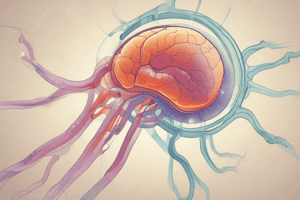Podcast
Questions and Answers
What is the primary function of tubular reabsorption in the kidneys?
What is the primary function of tubular reabsorption in the kidneys?
- To produce urine
- To return essential substances to the bloodstream (correct)
- To remove waste products from the blood
- To filter blood cells and proteins
In what part of the kidney does tubular reabsorption primarily occur?
In what part of the kidney does tubular reabsorption primarily occur?
- Glomerulus
- Renal tubule (correct)
- Bowman's capsule
- Renal pelvis
What type of substances are almost entirely reabsorbed in the tubules?
What type of substances are almost entirely reabsorbed in the tubules?
- Inorganic salts
- Toxins
- Metabolic wastes
- Organic nutrients (correct)
Which process describes the movement of substances from the peritubular capillaries into the renal tubule?
Which process describes the movement of substances from the peritubular capillaries into the renal tubule?
What is the role of antidiuretic hormone (ADH) in water reabsorption?
What is the role of antidiuretic hormone (ADH) in water reabsorption?
Which hormone regulates sodium reabsorption by the distal tubule and collecting duct?
Which hormone regulates sodium reabsorption by the distal tubule and collecting duct?
What is the driving force for the reabsorption of water in the proximal tubule?
What is the driving force for the reabsorption of water in the proximal tubule?
Which ion's reabsorption is primarily controlled by parathyroid hormone (PTH)?
Which ion's reabsorption is primarily controlled by parathyroid hormone (PTH)?
Where does the majority of obligatory water reabsorption occur?
Where does the majority of obligatory water reabsorption occur?
What is the impact of atrial natriuretic peptide (ANP) on sodium reabsorption in the kidneys?
What is the impact of atrial natriuretic peptide (ANP) on sodium reabsorption in the kidneys?
In the kidneys, what is meant by the term 'tubular secretion'?
In the kidneys, what is meant by the term 'tubular secretion'?
Which of the following is NOT typically reabsorbed in the tubules?
Which of the following is NOT typically reabsorbed in the tubules?
What type of transport requires energy (ATP) for reabsorption in the kidney tubules?
What type of transport requires energy (ATP) for reabsorption in the kidney tubules?
Regarding water reabsorption, what is the role of aquaporins?
Regarding water reabsorption, what is the role of aquaporins?
What percentage of filtrate volume is typically reabsorbed?
What percentage of filtrate volume is typically reabsorbed?
If blood pH is too acidic, what will the kidney tubules secrete?
If blood pH is too acidic, what will the kidney tubules secrete?
In which part of the nephron is the filtrate's osmolarity highest?
In which part of the nephron is the filtrate's osmolarity highest?
How does aldosterone affect potassium levels in the body?
How does aldosterone affect potassium levels in the body?
What is the primary role of the sodium-potassium pump in tubular reabsorption?
What is the primary role of the sodium-potassium pump in tubular reabsorption?
If a patient has high blood pressure, which hormone would the body likely release to reduce sodium reabsorption?
If a patient has high blood pressure, which hormone would the body likely release to reduce sodium reabsorption?
Flashcards
Tubular Reabsorption
Tubular Reabsorption
The process where the body takes back substances from the filtrate in the kidney tubules into the blood.
Glomerular Filtration
Glomerular Filtration
The initial step in urine formation where water and small solutes are filtered from the blood into the Bowman's capsule.
Tubular Secretion
Tubular Secretion
The process where the kidney tubules actively transport substances from the blood into the filtrate to be excreted.
Trans-epithelial Transport
Trans-epithelial Transport
Signup and view all the flashcards
Active Transport
Active Transport
Signup and view all the flashcards
Passive Transport
Passive Transport
Signup and view all the flashcards
Cotransport Reabsorption
Cotransport Reabsorption
Signup and view all the flashcards
Water Reabsorption
Water Reabsorption
Signup and view all the flashcards
Aquaporins
Aquaporins
Signup and view all the flashcards
Aldosterone
Aldosterone
Signup and view all the flashcards
ADH (Antidiuretic Hormone)
ADH (Antidiuretic Hormone)
Signup and view all the flashcards
ANP (Atrial Natriuretic Peptide)
ANP (Atrial Natriuretic Peptide)
Signup and view all the flashcards
PTH (Parathyroid Hormone)
PTH (Parathyroid Hormone)
Signup and view all the flashcards
Descending Limb
Descending Limb
Signup and view all the flashcards
Ascending Limb
Ascending Limb
Signup and view all the flashcards
Study Notes
- Urine formation involves tubular reabsorption as a key process in the urinary system.
The Solution
- Blood undergoes glomerular filtration, where it is filtered (without cells or proteins) and the filtrate is dumped into a waste container.
- Tubular reabsorption involves taking back substances the body needs to keep.
- Tubular secretion adds substances to the container based on the body's status to keep blood balanced.
- What is removed from the body as urine undergoes tubular secretion.
Tubular Reabsorption
- It is a selective trans-epithelial process
- Almost all organic nutrients are reabsorbed.
- Water and ion reabsorption is hormonally regulated and adjusted.
- The processes can be active (requiring ATP) or passive.
- Sodium potassium pumps are important for tubular reabsorption, assisting in getting substances back into the blood as water follows salt.
Reabsorption Locations
- Water can leave the descending limb, while most solutes cannot.
- Solutes can leave the ascending limb, while most water cannot.
Regulatory Factors
- The body changes reabsorption and secretion to meet the needs
- Andieuretic hormone (ADH) inhibits urine output.
- Aldosterone fine-tunes resorption of sodium, after which water follows.
- Atrial natriuretic peptide (ANP) causes less reabsorption of sodium, decreasing blood pressure.
- Parathyroid hormone (PTH) controls the rate of sodium reabsorption.
Studying That Suits You
Use AI to generate personalized quizzes and flashcards to suit your learning preferences.




